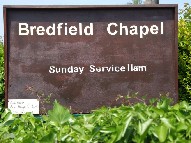| |
|
Bredfield
is a lovely village. It is handy for Woodbridge,
a town I admire but one in which I couldn't
imagine living, being full, as it is, of the kind
of people who would live in a place like
Woodbridge. But it is also close to the dozy,
verdant rolling landscape where the streams
collect to become the majestic Deben. It will be
familiar to many Suffolk people for the elaborate
wrought iron canopy with quaint, finger pointing
direction boards, which towers over the village
pump at the junction on the road to Boulge. Most 19th
century East Suffolkers owed allegiance to the
chapel rather than the church, but the Suffolk
returns for the 1851 census of Religious Worship
contain a very curious entry for this village. I
looked it up to see if there was a precursor to
this chapel, and found what was refered to as the
Little (Independent Village) Meeting House. The
Reverend Mr Ross, the 'Congregational Minister', declines
to make any return to this paper, the
congregation attending here being chiefly entered
as attending elsewhere. Sunday scholars attending
here in morning are mostly attendants at church
in afternoon and are, I believe, entered in the
church return. This must be the only
incidence in the entire census of a minister
talking down the congregation of his church
rather than talking it up. The inference must be
that there was no chapel, and that the one
registered in 1811 was merely an outpost of
Beaumont Congregational chapel in nearby
Woodbridge, meeting in private houses.
| This pretty little red brick
chapel has an inscribed stone dated 1902
telling us that it was the Gospel Mission
Room. I imagine that some enthusiastic
local firebrand had achieved a following,
and eventually was able to raise the
money to build a permanent home for his
sermons. 1902 was at the height of the
Temperance Movement in England, and
perhaps it is likely that this was a
significant element of the community
here. In Norfolk, they
embraced Methodism enthusiastically, but
here in Suffolk the puritan fire of the
past still burned strongly enough in the
bones of the average non-conformist for
him to be suspicious of big
organisations. Congregationalism was the
brand of choice, and most of these
independent chapels out in the sticks
chose not to join the United Reformed
Church when it came along. As independent
chapels they continue today.
|
|
 |
|
|
|

